Target Information
| Target General Information | Top | |||||
|---|---|---|---|---|---|---|
| Target ID |
T92828
(Former ID: TTDS00199)
|
|||||
| Target Name |
Endothelin B receptor (EDNRB)
|
|||||
| Synonyms |
Endothelin receptor type B; Endothelin receptor Non-selective type; Endothelin receptor B; ETRB; ET-BR; ET-B
Click to Show/Hide
|
|||||
| Gene Name |
EDNRB
|
|||||
| Target Type |
Successful target
|
[1] | ||||
| Disease | [+] 2 Target-related Diseases | + | ||||
| 1 | Cardiovascular disease [ICD-11: BA00-BE2Z] | |||||
| 2 | Pulmonary hypertension [ICD-11: BB01] | |||||
| Function |
Mediates its action by association with G proteins that activate a phosphatidylinositol-calcium second messenger system. Non-specific receptor for endothelin 1, 2, and 3.
Click to Show/Hide
|
|||||
| BioChemical Class |
GPCR rhodopsin
|
|||||
| UniProt ID | ||||||
| Sequence |
MQPPPSLCGRALVALVLACGLSRIWGEERGFPPDRATPLLQTAEIMTPPTKTLWPKGSNA
SLARSLAPAEVPKGDRTAGSPPRTISPPPCQGPIEIKETFKYINTVVSCLVFVLGIIGNS TLLRIIYKNKCMRNGPNILIASLALGDLLHIVIDIPINVYKLLAEDWPFGAEMCKLVPFI QKASVGITVLSLCALSIDRYRAVASWSRIKGIGVPKWTAVEIVLIWVVSVVLAVPEAIGF DIITMDYKGSYLRICLLHPVQKTAFMQFYKTAKDWWLFSFYFCLPLAITAFFYTLMTCEM LRKKSGMQIALNDHLKQRREVAKTVFCLVLVFALCWLPLHLSRILKLTLYNQNDPNRCEL LSFLLVLDYIGINMASLNSCINPIALYLVSKRFKNCFKSCLCCWCQSFEEKQSLEEKQSC LKFKANDHGYDNFRSSNKYSSS Click to Show/Hide
|
|||||
| 3D Structure | Click to Show 3D Structure of This Target | AlphaFold | ||||
| HIT2.0 ID | T37YKZ | |||||
| Drugs and Modes of Action | Top | |||||
|---|---|---|---|---|---|---|
| Approved Drug(s) | [+] 2 Approved Drugs | + | ||||
| 1 | Bosentan | Drug Info | Approved | Pulmonary arterial hypertension | [2], [3] | |
| 2 | Macitentan | Drug Info | Approved | Cardiovascular disease | [1], [4], [5] | |
| Clinical Trial Drug(s) | [+] 4 Clinical Trial Drugs | + | ||||
| 1 | BQ788 | Drug Info | Phase 3 | Acute kidney injury | [6] | |
| 2 | PD-145065 | Drug Info | Phase 2 | Hypertension | [7] | |
| 3 | SPI-1620 | Drug Info | Phase 2 | Solid tumour/cancer | [8], [9] | |
| 4 | ENB003 | Drug Info | Phase 1/2 | Melanoma | [10] | |
| Discontinued Drug(s) | [+] 3 Discontinued Drugs | + | ||||
| 1 | ENRASENTAN | Drug Info | Discontinued in Phase 2 | Pulmonary arterial hypertension | [11] | |
| 2 | J-104132 | Drug Info | Discontinued in Phase 2 | Pulmonary arterial hypertension | [12] | |
| 3 | SB-209670 | Drug Info | Discontinued in Phase 2 | Arrhythmia | [13], [14] | |
| Mode of Action | [+] 4 Modes of Action | + | ||||
| Modulator | [+] 7 Modulator drugs | + | ||||
| 1 | Bosentan | Drug Info | [15] | |||
| 2 | Macitentan | Drug Info | [1] | |||
| 3 | PD-145065 | Drug Info | [7] | |||
| 4 | ENRASENTAN | Drug Info | [19] | |||
| 5 | J-104132 | Drug Info | [20] | |||
| 6 | SB-209670 | Drug Info | [21], [22] | |||
| 7 | ENDG-4010 | Drug Info | [29] | |||
| Antagonist | [+] 7 Antagonist drugs | + | ||||
| 1 | BQ788 | Drug Info | [16] | |||
| 2 | ENB003 | Drug Info | [10] | |||
| 3 | PD142893 | Drug Info | [24] | |||
| 4 | A192621 | Drug Info | [26] | |||
| 5 | LU302872 | Drug Info | [31] | |||
| 6 | Ro 46-8443 | Drug Info | [29] | |||
| 7 | Sarafotoxin 6C | Drug Info | [24] | |||
| Agonist | [+] 3 Agonist drugs | + | ||||
| 1 | SPI-1620 | Drug Info | [17], [18] | |||
| 2 | BQ 3020 | Drug Info | [28] | |||
| 3 | [125I]IRL1620 | Drug Info | [29] | |||
| Inhibitor | [+] 15 Inhibitor drugs | + | ||||
| 1 | ET-1 | Drug Info | [23] | |||
| 2 | IRL-2500 | Drug Info | [23] | |||
| 3 | RES-701-1 | Drug Info | [25] | |||
| 4 | Ac-bhg-F-N-Y-Y-W | Drug Info | [27] | |||
| 5 | Ac-w-F-F-N-Y-Y-W | Drug Info | [27] | |||
| 6 | Bhg-F-N-Y-Y-W | Drug Info | [27] | |||
| 7 | Endothelin-3 | Drug Info | [30] | |||
| 8 | IRL-1722 | Drug Info | [23] | |||
| 9 | IRL-1841 | Drug Info | [23] | |||
| 10 | Linear peptide of RES-701-1 | Drug Info | [25] | |||
| 11 | PD-163140 | Drug Info | [32] | |||
| 12 | RES-701-1-C-terminal analogue | Drug Info | [33] | |||
| 13 | Trp-Ile-Ile-Asp-Leu-Hisc(Cys-Ser-Val-Tyr-Phe-Cys) | Drug Info | [34] | |||
| 14 | Trp-Ile-Ile-Asp-Leu-Hisc(Cys-Val-Tyr-Phe-Cys) | Drug Info | [34] | |||
| 15 | W-F-F-N--Y-Y-W | Drug Info | [27] | |||
| Cell-based Target Expression Variations | Top | |||||
|---|---|---|---|---|---|---|
| Cell-based Target Expression Variations | ||||||
| Different Human System Profiles of Target | Top |
|---|---|
|
Human Similarity Proteins
of target is determined by comparing the sequence similarity of all human proteins with the target based on BLAST. The similarity proteins for a target are defined as the proteins with E-value < 0.005 and outside the protein families of the target.
A target that has fewer human similarity proteins outside its family is commonly regarded to possess a greater capacity to avoid undesired interactions and thus increase the possibility of finding successful drugs
(Brief Bioinform, 21: 649-662, 2020).
Human Tissue Distribution
of target is determined from a proteomics study that quantified more than 12,000 genes across 32 normal human tissues. Tissue Specificity (TS) score was used to define the enrichment of target across tissues.
The distribution of targets among different tissues or organs need to be taken into consideration when assessing the target druggability, as it is generally accepted that the wider the target distribution, the greater the concern over potential adverse effects
(Nat Rev Drug Discov, 20: 64-81, 2021).
Human Pathway Affiliation
of target is determined by the life-essential pathways provided on KEGG database. The target-affiliated pathways were defined based on the following two criteria (a) the pathways of the studied target should be life-essential for both healthy individuals and patients, and (b) the studied target should occupy an upstream position in the pathways and therefore had the ability to regulate biological function.
Targets involved in a fewer pathways have greater likelihood to be successfully developed, while those associated with more human pathways increase the chance of undesirable interferences with other human processes
(Pharmacol Rev, 58: 259-279, 2006).
Biological Network Descriptors
of target is determined based on a human protein-protein interactions (PPI) network consisting of 9,309 proteins and 52,713 PPIs, which were with a high confidence score of ≥ 0.95 collected from STRING database.
The network properties of targets based on protein-protein interactions (PPIs) have been widely adopted for the assessment of target’s druggability. Proteins with high node degree tend to have a high impact on network function through multiple interactions, while proteins with high betweenness centrality are regarded to be central for communication in interaction networks and regulate the flow of signaling information
(Front Pharmacol, 9, 1245, 2018;
Curr Opin Struct Biol. 44:134-142, 2017).
Human Similarity Proteins
Human Tissue Distribution
Human Pathway Affiliation
Biological Network Descriptors
|
|
|
Note:
If a protein has TS (tissue specficity) scores at least in one tissue >= 2.5, this protein is called tissue-enriched (including tissue-enriched-but-not-specific and tissue-specific). In the plots, the vertical lines are at thresholds 2.5 and 4.
|
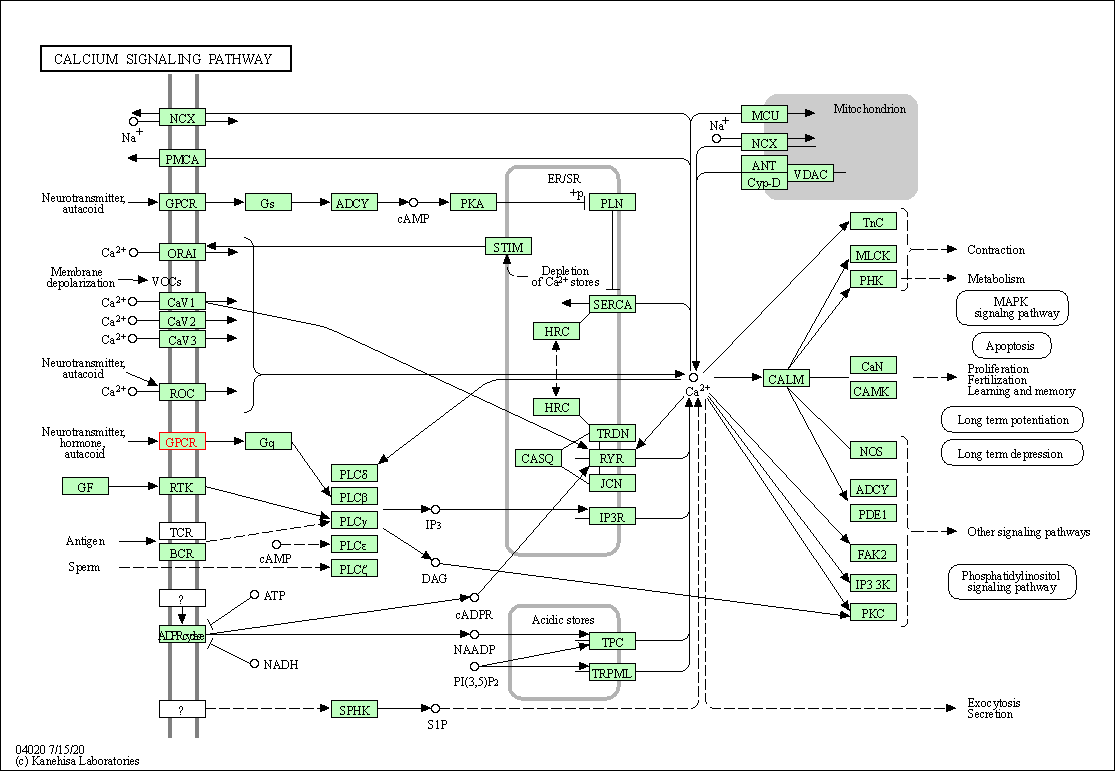
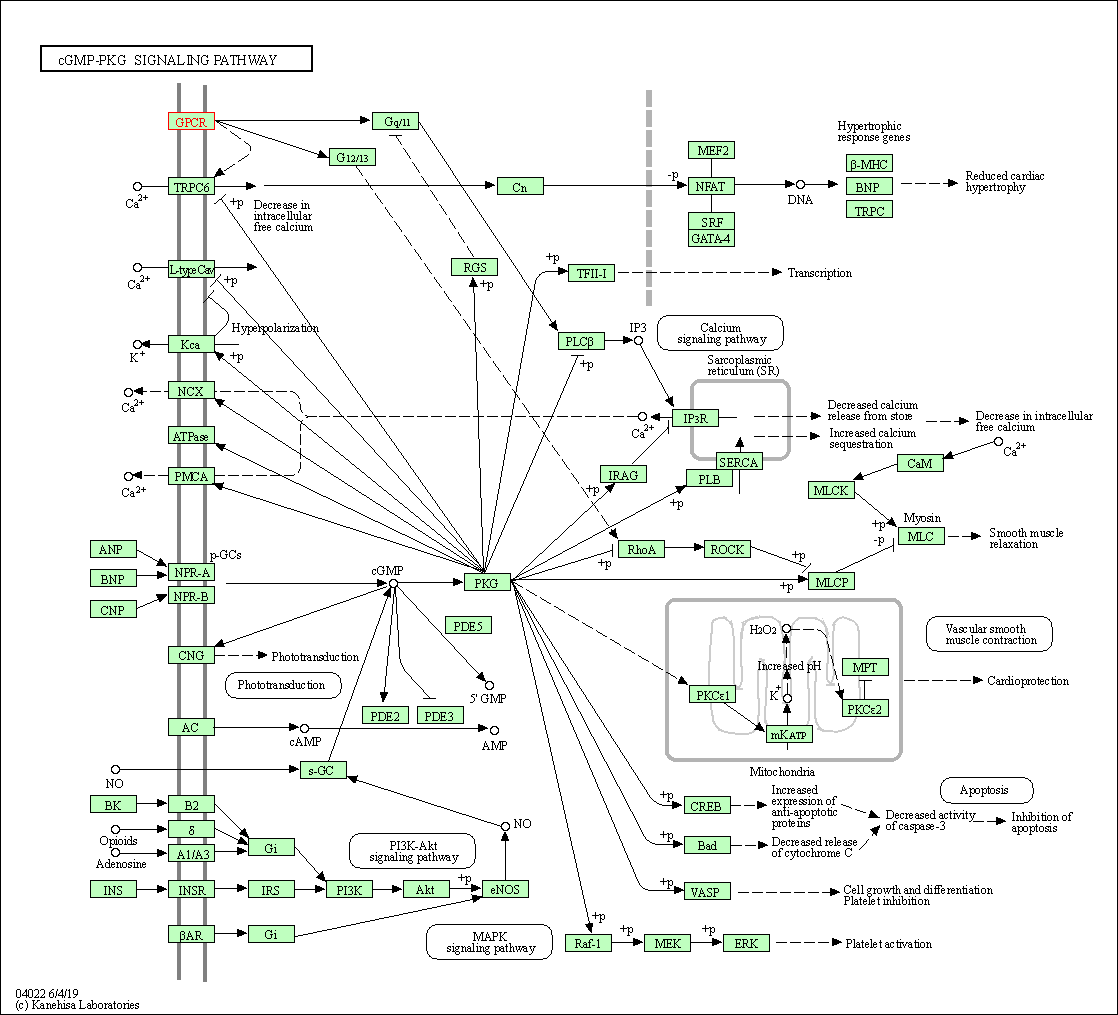
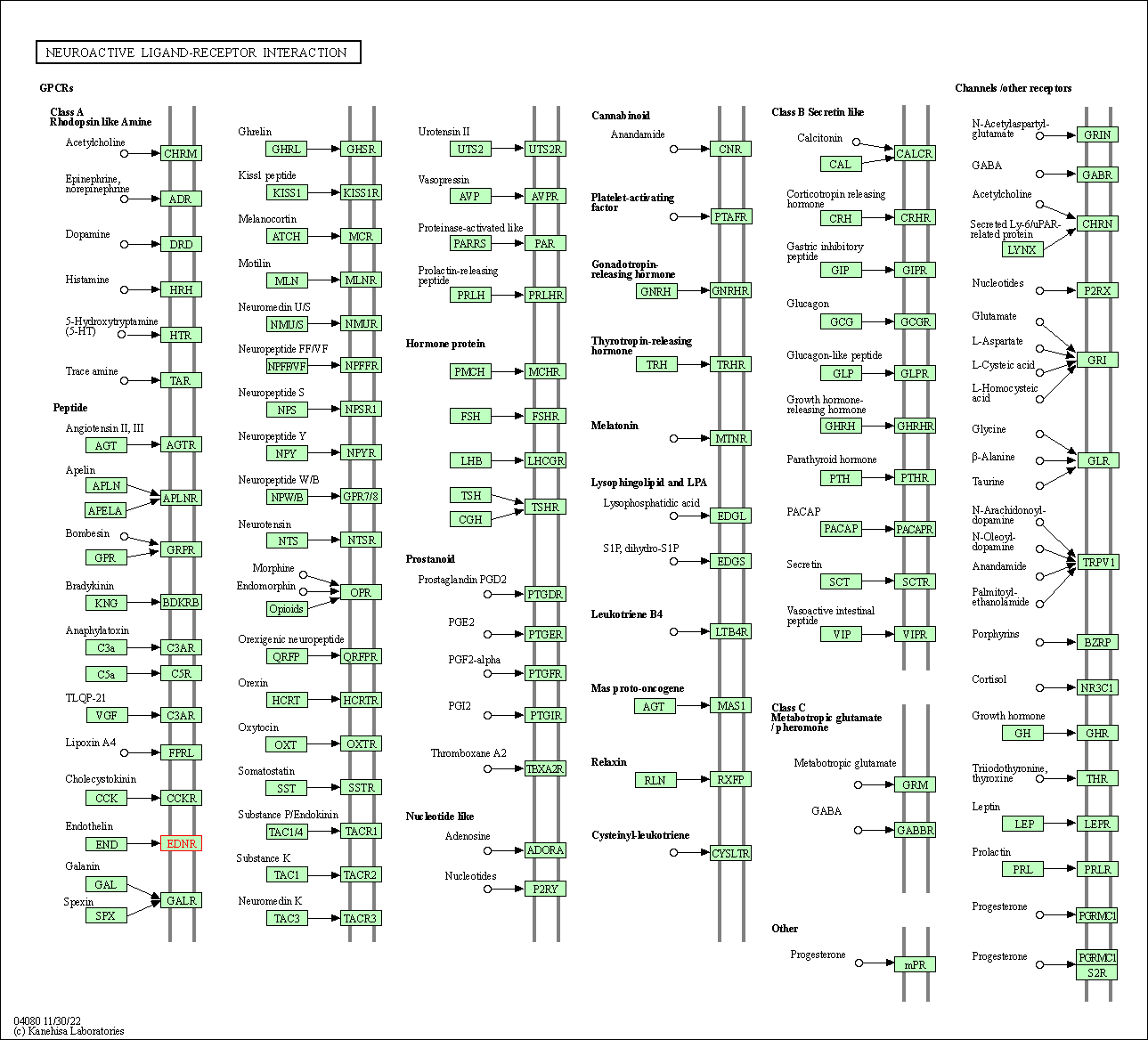
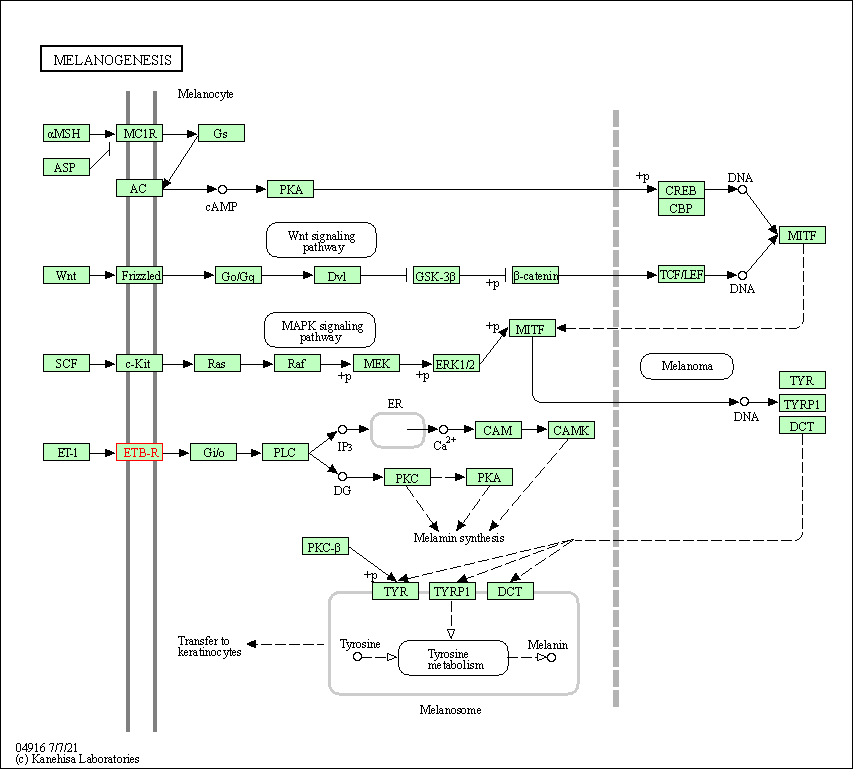
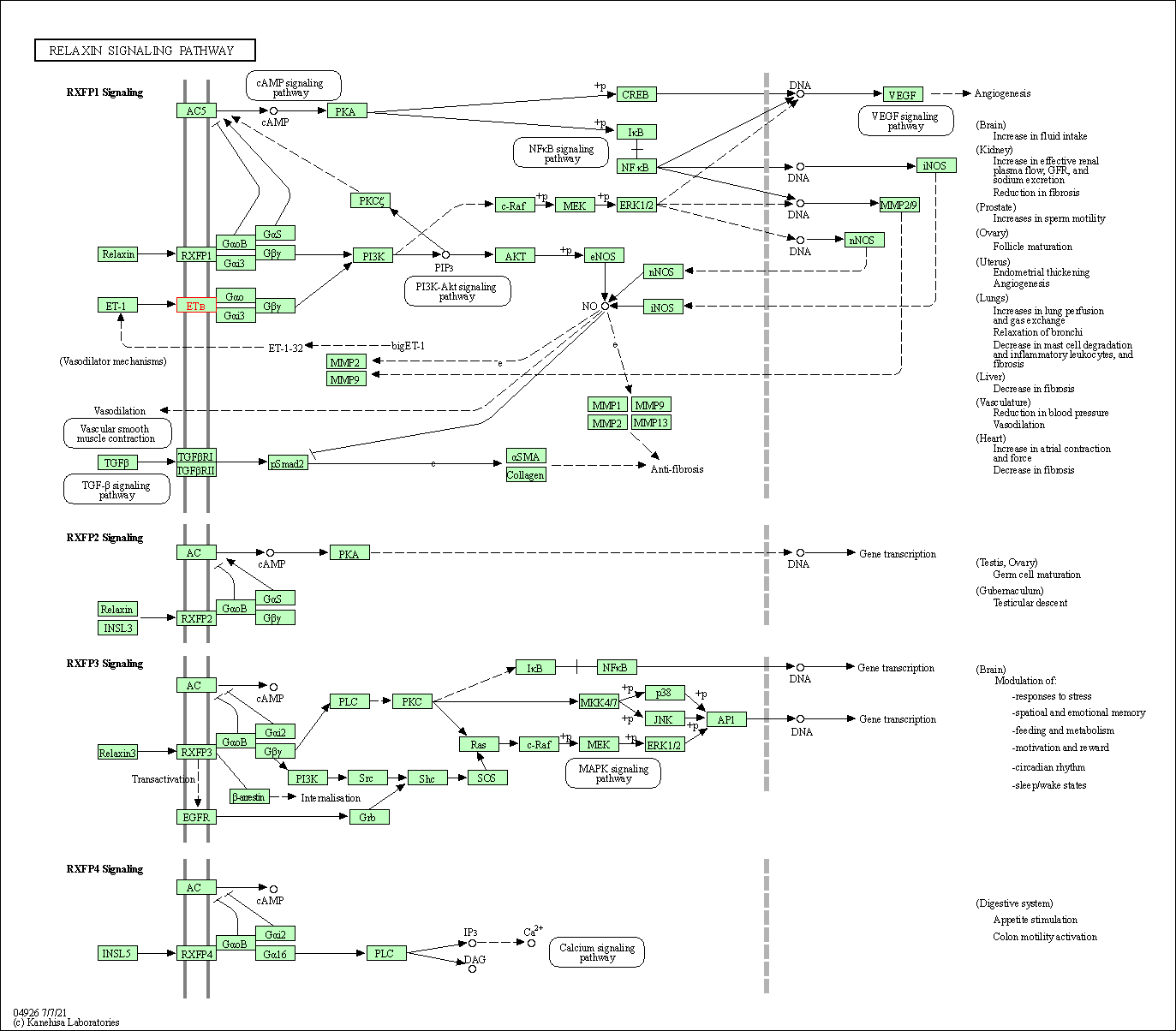
| KEGG Pathway | Pathway ID | Affiliated Target | Pathway Map |
|---|---|---|---|
| Calcium signaling pathway | hsa04020 | Affiliated Target |

|
| Class: Environmental Information Processing => Signal transduction | Pathway Hierarchy | ||
| cGMP-PKG signaling pathway | hsa04022 | Affiliated Target |

|
| Class: Environmental Information Processing => Signal transduction | Pathway Hierarchy | ||
| Neuroactive ligand-receptor interaction | hsa04080 | Affiliated Target |

|
| Class: Environmental Information Processing => Signaling molecules and interaction | Pathway Hierarchy | ||
| Melanogenesis | hsa04916 | Affiliated Target |

|
| Class: Organismal Systems => Endocrine system | Pathway Hierarchy | ||
| Relaxin signaling pathway | hsa04926 | Affiliated Target |

|
| Class: Organismal Systems => Endocrine system | Pathway Hierarchy | ||
| Degree | 5 | Degree centrality | 5.37E-04 | Betweenness centrality | 4.99E-04 |
|---|---|---|---|---|---|
| Closeness centrality | 2.02E-01 | Radiality | 1.35E+01 | Clustering coefficient | 1.00E-01 |
| Neighborhood connectivity | 1.64E+01 | Topological coefficient | 2.39E-01 | Eccentricity | 12 |
| Download | Click to Download the Full PPI Network of This Target | ||||
| Chemical Structure based Activity Landscape of Target | Top |
|---|---|
| Drug Property Profile of Target | Top | |
|---|---|---|
| (1) Molecular Weight (mw) based Drug Clustering | (2) Octanol/Water Partition Coefficient (xlogp) based Drug Clustering | |
|
|
||
| (3) Hydrogen Bond Donor Count (hbonddonor) based Drug Clustering | (4) Hydrogen Bond Acceptor Count (hbondacc) based Drug Clustering | |
|
|
||
| (5) Rotatable Bond Count (rotbonds) based Drug Clustering | (6) Topological Polar Surface Area (polararea) based Drug Clustering | |
|
|
||
| "RO5" indicates the cutoff set by lipinski's rule of five; "D123AB" colored in GREEN denotes the no violation of any cutoff in lipinski's rule of five; "D123AB" colored in PURPLE refers to the violation of only one cutoff in lipinski's rule of five; "D123AB" colored in BLACK represents the violation of more than one cutoffs in lipinski's rule of five | ||
| Co-Targets | Top | |||||
|---|---|---|---|---|---|---|
| Co-Targets | ||||||
| Target Poor or Non Binders | Top | |||||
|---|---|---|---|---|---|---|
| Target Poor or Non Binders | ||||||
| Target Affiliated Biological Pathways | Top | |||||
|---|---|---|---|---|---|---|
| KEGG Pathway | [+] 5 KEGG Pathways | + | ||||
| 1 | Calcium signaling pathway | |||||
| 2 | cGMP-PKG signaling pathway | |||||
| 3 | Neuroactive ligand-receptor interaction | |||||
| 4 | Melanogenesis | |||||
| 5 | Pathways in cancer | |||||
| Panther Pathway | [+] 1 Panther Pathways | + | ||||
| 1 | Endothelin signaling pathway | |||||
| PID Pathway | [+] 2 PID Pathways | + | ||||
| 1 | Endothelins | |||||
| 2 | Arf6 trafficking events | |||||
| Reactome | [+] 2 Reactome Pathways | + | ||||
| 1 | Peptide ligand-binding receptors | |||||
| 2 | G alpha (q) signalling events | |||||
| WikiPathways | [+] 7 WikiPathways | + | ||||
| 1 | Prostaglandin Synthesis and Regulation | |||||
| 2 | GPCRs, Class A Rhodopsin-like | |||||
| 3 | Gastrin-CREB signalling pathway via PKC and MAPK | |||||
| 4 | Peptide GPCRs | |||||
| 5 | Endothelin Pathways | |||||
| 6 | GPCR ligand binding | |||||
| 7 | GPCR downstream signaling | |||||
| Target-Related Models and Studies | Top | |||||
|---|---|---|---|---|---|---|
| Target Validation | ||||||
| References | Top | |||||
|---|---|---|---|---|---|---|
| REF 1 | Radium 223 dichloride for prostate cancer treatment. Drug Des Devel Ther. 2017 Sep 6;11:2643-2651. | |||||
| REF 2 | URL: http://www.guidetopharmacology.org Nucleic Acids Res. 2015 Oct 12. pii: gkv1037. The IUPHAR/BPS Guide to PHARMACOLOGY in 2016: towards curated quantitative interactions between 1300 protein targets and 6000 ligands. (Ligand id: 3494). | |||||
| REF 3 | Optimizing endothelin receptor antagonist use in the management of pulmonary arterial hypertension. Vasc Health Risk Manag. 2008;4(5):943-52. | |||||
| REF 4 | URL: http://www.guidetopharmacology.org Nucleic Acids Res. 2015 Oct 12. pii: gkv1037. The IUPHAR/BPS Guide to PHARMACOLOGY in 2016: towards curated quantitative interactions between 1300 protein targets and 6000 ligands. (Ligand id: 7352). | |||||
| REF 5 | Drugs@FDA. U.S. Food and Drug Administration. U.S. Department of Health & Human Services. 2015 | |||||
| REF 6 | Clinical pipeline report, company report or official report of the Pharmaceutical Research and Manufacturers of America (PhRMA) | |||||
| REF 7 | Reversal of established responses to endothelin-1 in vivo and in vitro by the endothelin receptor antagonists, BQ-123 and PD 145065. Br J Pharmacol. 1994 May;112(1):207-13. | |||||
| REF 8 | URL: http://www.guidetopharmacology.org Nucleic Acids Res. 2015 Oct 12. pii: gkv1037. The IUPHAR/BPS Guide to PHARMACOLOGY in 2016: towards curated quantitative interactions between 1300 protein targets and 6000 ligands. (Ligand id: 3886). | |||||
| REF 9 | Trusted, scientifically sound profiles of drug programs, clinical trials, safety reports, and company deals, written by scientists. Springer. 2015. Adis Insight (drug id 800003990) | |||||
| REF 10 | ClinicalTrials.gov (NCT04205227) A Phase 1/2A Trial of ENB 003 in Combination With Pembrolizumab in Subjects With Advanced Solid Tumors. U.S.National Institutes of Health. | |||||
| REF 11 | Trusted, scientifically sound profiles of drug programs, clinical trials, safety reports, and company deals, written by scientists. Springer. 2015. Adis Insight (drug id 800004637) | |||||
| REF 12 | Trusted, scientifically sound profiles of drug programs, clinical trials, safety reports, and company deals, written by scientists. Springer. 2015. Adis Insight (drug id 800010566) | |||||
| REF 13 | URL: http://www.guidetopharmacology.org Nucleic Acids Res. 2015 Oct 12. pii: gkv1037. The IUPHAR/BPS Guide to PHARMACOLOGY in 2016: towards curated quantitative interactions between 1300 protein targets and 6000 ligands. (Ligand id: 3528). | |||||
| REF 14 | Trusted, scientifically sound profiles of drug programs, clinical trials, safety reports, and company deals, written by scientists. Springer. 2015. Adis Insight (drug id 800003996) | |||||
| REF 15 | Drugs@FDA. U.S. Food and Drug Administration. U.S. Department of Health & Human Services. | |||||
| REF 16 | BQ788, an endothelin ET(B) receptor antagonist, attenuates stab wound injury-induced reactive astrocytes in rat brain. Glia. 1999 May;26(3):268-71. | |||||
| REF 17 | Clinical pipeline report, company report or official report of Spectrum Phamaceuticals (2009). | |||||
| REF 18 | The efficacy and tolerability of two novel H(1)/H(3) receptor antagonists in seasonal allergic rhinitis. Int Arch Allergy Immunol. 2012;158(1):84-98. | |||||
| REF 19 | Enrasentan, an antagonist of endothelin receptors. Cardiovasc Drug Rev. 2003 Spring;21(1):1-16. | |||||
| REF 20 | Pharmacological properties of J-104132 (L-753,037), a potent, orally active, mixed ETA/ETB endothelin receptor antagonist. J Pharmacol Exp Ther. 1999 Jun;289(3):1262-70. | |||||
| REF 21 | Effects of the endothelin receptor antagonist, SB 209670, on circulatory failure and organ injury in endotoxic shock in the anaesthetized rat. Br J Pharmacol. 1996 May;118(1):198-204. | |||||
| REF 22 | Nonpeptide endothelin receptor antagonists. III. Effect of SB 209670 and BQ123 on acute renal failure in anesthetized dogs. J Pharmacol Exp Ther. 1994 Nov;271(2):769-75. | |||||
| REF 23 | IRL 2500: A potent ETB selective endothelin antagonist, Bioorg. Med. Chem. Lett. 6(19):2323-2328 (1996). | |||||
| REF 24 | Human optic nerve head astrocytes as a target for endothelin-1. Invest Ophthalmol Vis Sci. 2002 Aug;43(8):2704-13. | |||||
| REF 25 | RES-701-1/endothelin-1 hybrid peptide having a potent binding activity for type B receptor, Bioorg. Med. Chem. Lett. 7(13):1715-1720 (1997). | |||||
| REF 26 | Pyrrolidine-3-carboxylic acids as endothelin antagonists. 4. Side chain conformational restriction leads to ET(B) selectivity. J Med Chem. 1999 Sep 9;42(18):3668-78. | |||||
| REF 27 | Res-701-1, synthesis and a reevaluation of its effects on the endothelin receptors, Bioorg. Med. Chem. Lett. 5(6):621-626 (1995). | |||||
| REF 28 | Pharmacological differences between rat and human endothelin B receptors. Biochem Biophys Res Commun. 1995 Apr 17;209(2):506-12. | |||||
| REF 29 | URL: http://www.guidetopharmacology.org Nucleic Acids Res. 2015 Oct 12. pii: gkv1037. The IUPHAR/BPS Guide to PHARMACOLOGY in 2016: towards curated quantitative interactions between 1300 protein targets and 6000 ligands. (Target id: 220). | |||||
| REF 30 | cis-4-(Piperazin-1-yl)-5,6,7a,8,9,10,11,11a-octahydrobenzofuro[2,3-h]quinazolin-2-amine (A-987306), a new histamine H4R antagonist that blocks pain... J Med Chem. 2008 Nov 27;51(22):7094-8. | |||||
| REF 31 | Influence of endothelin receptor antagonists on myocardial protein kinase C isoforms in uraemic cardiomyopathy. Clin Sci (Lond). 2002 Aug;103 Suppl 48:276S-279S. | |||||
| REF 32 | gamma-Carbamate butenolide analogues as potent ETA selective endothelin receptor antagonists and prodrugs, Bioorg. Med. Chem. Lett. 7(3):297-302 (1997). | |||||
| REF 33 | Analogs of an endothelin antagonist RES-701-1: substitutions of C-terminal amino acid, Bioorg. Med. Chem. Lett. 6(7):775-778 (1996). | |||||
| REF 34 | Structure-activity relationships in a series of monocyclic endothelin analogues, Bioorg. Med. Chem. Lett. 4(4):567-572 (1994). | |||||
If You Find Any Error in Data or Bug in Web Service, Please Kindly Report It to Dr. Zhou and Dr. Zhang.

